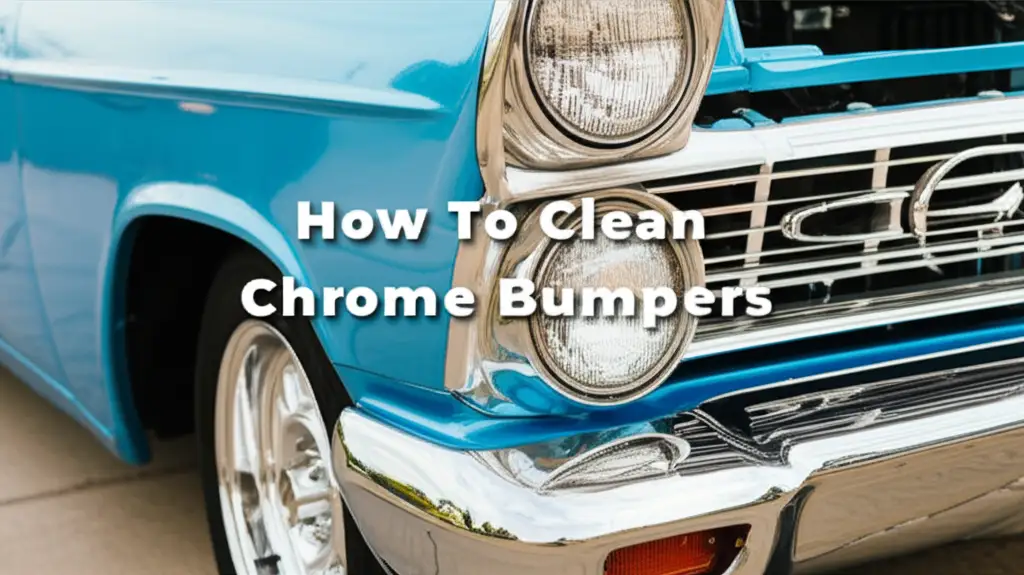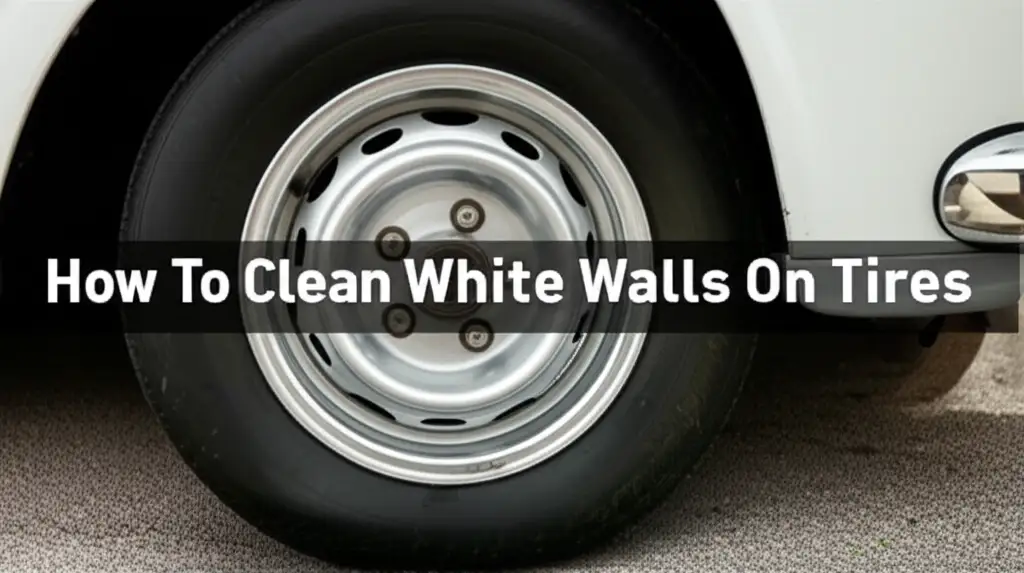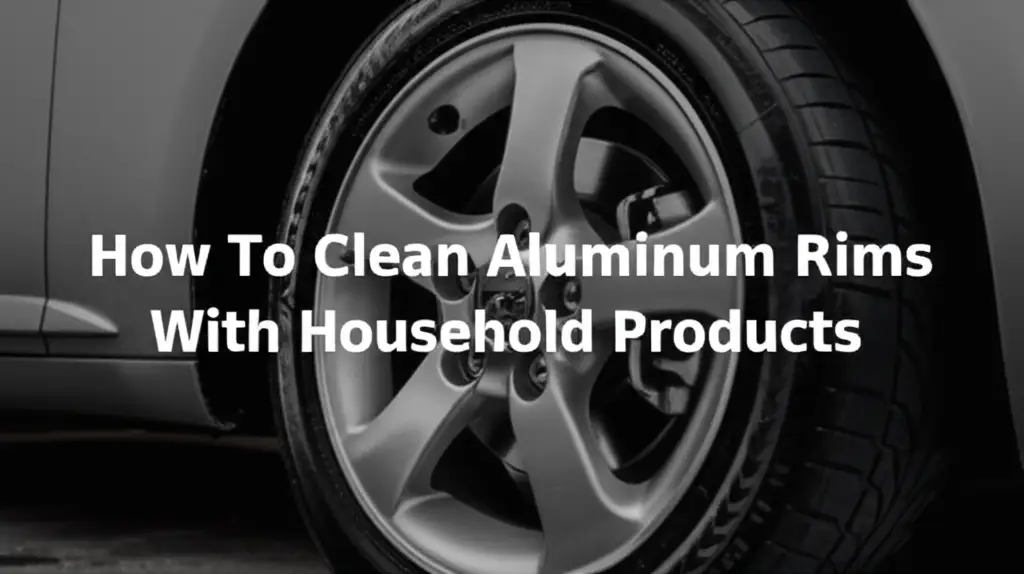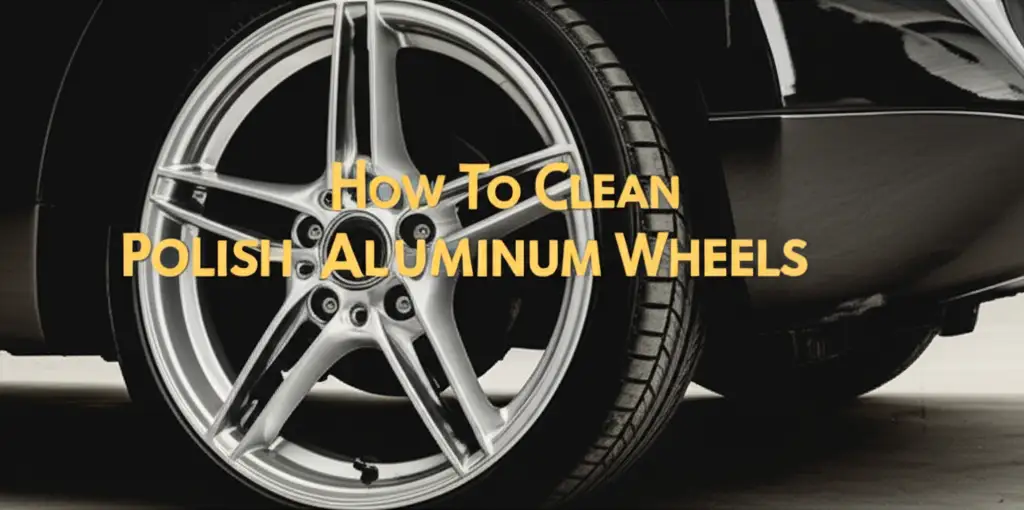· Auto Care · 19 min read
How To Clean Chrome Bumpers

Restore Your Ride: A Guide to Cleaning Chrome Bumpers
Have you looked at your car’s chrome bumpers lately? These shiny elements add a classic touch to any vehicle. Over time, however, dirt, grime, and even rust can dull their sparkle. Learning how to clean chrome bumpers effectively keeps your vehicle looking its best. This article provides a comprehensive guide. We will cover the tools you need, detailed cleaning steps, methods for removing tough stains, and tips for long-term care.
Takeaway
Keeping your chrome bumpers shining requires regular cleaning and proper protection. Use gentle methods to prevent scratches. Address rust and stains quickly. Applying a protective wax or sealant extends their lifespan and maintains their brilliant look.
Answer to Main Query
To clean chrome bumpers, start by rinsing off loose dirt. Wash them with car wash soap and a soft sponge. For tougher grime, use specialized chrome cleaner or a vinegar solution. Rinse thoroughly and dry immediately with a microfiber cloth to prevent water spots, then polish for shine.
Why Keeping Chrome Bumpers Clean Matters
Chrome bumpers do more than just make your car look good. They provide a layer of protection for your vehicle. A clean bumper also shows you care about your car’s appearance. Dirt and road salt can damage chrome over time. This damage leads to pitting and rust.
Maintaining chrome bumpers helps keep their value. A well-kept car often sells for more money. Regular cleaning also stops small issues from becoming big problems. Pitting and rust are hard to fix once they start. Keeping chrome clean helps it last longer. This protects your investment.
The Appeal of Shine
Shiny chrome bumpers catch the eye. They give your car a polished, luxurious look. This shine makes an old car look newer. It makes a new car look even better. People notice a car with clean, sparkling chrome. It reflects light beautifully.
A dull, dirty bumper detracts from your car’s overall appearance. It shows neglect. Cleaning chrome bumpers brings back that original luster. It restores the car’s visual appeal. You will feel proud driving your car with shining bumpers.
Preventing Damage and Rust
Chrome is a durable finish, but it is not indestructible. Road salt, bird droppings, and industrial fallout can corrode the surface. These elements can cause small pits to form. Once the chrome layer is broken, moisture can reach the metal underneath. This causes rust.
Rust is difficult to remove from chrome. It spreads quickly once it starts. Regular cleaning removes these harmful substances before they cause damage. It forms a protective barrier. This protects the chrome from harsh elements. Preventing damage is easier than repairing it.
Essential Tools and Supplies for Cleaning Chrome Bumpers
Before you begin cleaning your chrome bumpers, gather all your supplies. Having everything ready makes the process smoother. You will need a few basic cleaning items. Some specialized products are also helpful for tough jobs. These tools ensure you clean your chrome safely and effectively.
Basic Cleaning Agents
You will need a few common items for general cleaning. These items are safe for regular use. They help remove surface dirt without harsh scrubbing. Using the right tools prevents scratches. This keeps your chrome looking new.
- Two Buckets: One for soapy water, one for rinsing your sponge. This keeps your cleaning solution clean.
- Car Wash Soap: Use a pH-neutral car wash soap. This type of soap is gentle on car finishes. It will not strip any wax or sealant from your paint or chrome.
- Soft Sponges or Wash Mitts: Microfiber or lambswool mitts are best. They lift dirt away from the surface. This reduces the risk of scratching the chrome.
- Microfiber Towels: You need several clean, soft microfiber towels. These are perfect for drying and polishing. They absorb water well and leave no lint.
- Garden Hose with Spray Nozzle: For rinsing off dirt and soap. A good spray helps remove all residue.
Specialized Chrome Cleaners
For tougher stains or deeper cleaning, you might need specific products. These cleaners are formulated to handle chrome’s unique properties. They can remove rust and oxidation without damaging the finish.
- Dedicated Chrome Cleaner: Many brands make cleaners specifically for chrome. These products often contain mild abrasives or chemical agents. They are designed to safely remove tarnish and light rust. Look for cleaners that specify “safe for chrome.”
- Metal Polish: After cleaning, a metal polish brings out the shine. It removes any remaining haze. It also provides a light protective layer. Choose a polish designed for chrome or other bright metals.
- Rust Remover for Chrome: For significant rust spots, a dedicated rust remover might be necessary. Some products convert rust, making it easier to wipe away. Others dissolve the rust. Be sure it is safe for chrome.
- Clay Bar (Optional): A clay bar can remove embedded contaminants. These are things like rail dust or industrial fallout. It leaves the surface incredibly smooth. Use it with a clay lubricant.
You can also use some common household items. For example, distilled white vinegar can help with hard water spots. You can learn more about how vinegar helps with various cleaning tasks, for example, on surfaces like glass with vinegar. Baking soda mixed with water forms a mild paste for light abrasion. Always test any new product in a small, hidden area first. This ensures it does not harm your chrome.
Step-by-Step Guide to Cleaning Dirty Chrome Bumpers
Cleaning your chrome bumpers is a straightforward process. Follow these steps for the best results. A systematic approach ensures thorough cleaning. It also helps you avoid missing any spots. My experience tells me that a good routine makes all the difference.
Pre-Wash Preparation
Preparation is key for a successful chrome cleaning job. This step removes loose debris. It prepares the surface for deeper cleaning. Doing this first prevents scratching the chrome.
- Rinse Off Loose Dirt: Use your garden hose to spray down the chrome bumpers. Start from the top and work your way down. This removes dust, mud, and road grime. A strong spray helps dislodge stuck-on particles. This initial rinse is crucial.
- Inspect the Chrome: Take a moment to look closely at your bumpers. Note any areas with stubborn dirt, tar, or rust spots. This inspection helps you target problem areas. It also helps you choose the right tools for those spots.
Washing the Chrome
Once the loose dirt is gone, it is time for the main wash. This step removes built-up grime and road film. Use gentle products and techniques. This protects the delicate chrome finish.
- Prepare Cleaning Solution: Fill one bucket with water and add your pH-neutral car wash soap. Follow the product’s dilution instructions. Fill the second bucket with clean rinse water.
- Wash the Bumpers: Dip a soft sponge or wash mitt into the soapy water. Gently wipe the chrome bumpers. Work in small sections. Apply light pressure. Do not scrub hard, especially if you see stubborn dirt. Let the soap do the work.
- Rinse Your Mitt Often: Rinse your sponge or mitt in the clean water bucket frequently. This prevents transferring dirt back onto the chrome. Dirty water can scratch the surface.
- Re-apply Soap as Needed: If the chrome is very dirty, re-apply soap. Continue washing until the entire bumper is clean. Ensure you reach all crevices.
Rinsing and Drying
Rinsing and drying are critical steps. They prevent water spots and streaks. Proper drying reveals the true shine of the chrome. It also prepares the surface for polishing.
- Rinse Thoroughly: Use your hose to completely rinse off all soap residue. Make sure no suds remain. Soap residue can leave a film. It can attract more dirt later.
- Dry Immediately: Do not let the chrome air dry. Water, especially hard water, leaves mineral deposits. These become water spots. Use a clean, dry microfiber towel to dry the bumpers. Wipe in one direction. Buff lightly to remove any remaining moisture. Change towels if they become too damp. This step is important for a streak-free finish.
Following these steps provides a clean base for any further treatment. This prepares your chrome for polishing or protection. My own experience has shown me that patience in these early steps pays off. Clean chrome bumpers make your whole car stand out. This is a lot like cleaning other chrome items, such as when you clean chrome rims on your car or even smaller items like when you clean a chrome shower head. The principles of gentle cleaning and immediate drying are universal for chrome.
Removing Stubborn Stains and Rust from Chrome Bumpers
Sometimes, general washing is not enough. Chrome bumpers face harsh elements. They can develop stubborn stains or rust spots. Knowing how to deal with these issues is important. You can restore your chrome’s pristine look. Be patient and use the right approach.
Tackling Rust Spots
Rust is a common enemy of chrome bumpers. It appears as small, reddish-brown specks. These spots form when the protective chrome layer is breached. Act quickly to remove rust. This prevents it from spreading.
- Identify Rust Type: Surface rust is easier to remove. It sits on the chrome’s top layer. Pitting rust means the rust has eaten into the metal. This is more challenging.
- Mild Abrasive Method: For light surface rust, try a mild abrasive. You can mix baking soda with a little water to form a paste. Apply the paste to the rust spot. Gently rub with a soft cloth or fine steel wool (0000 grade). Rub in the direction of the grain, if any. Rinse thoroughly. This method is effective for minor blemishes.
- Chemical Rust Removers: For more stubborn rust, use a dedicated chrome rust remover. Apply the product as directed by the manufacturer. Often, you apply it, let it sit, then wipe it away. These products often contain mild acids. They dissolve the rust. Always wear gloves. Rinse the area completely after use.
- Aluminum Foil Method: Some people use a crumpled piece of aluminum foil. Dip the foil in water or a little cola. Rub it gently on the rust spot. The aluminum is softer than chrome. It forms a mild abrasive. This can lift light rust without scratching the chrome. Test this method in a small spot first.
Dealing with Tar and Grime
Tar, bug splatter, and tree sap are common culprits that stick to bumpers. These substances bond strongly to the chrome. They require specific methods for removal. Do not try to scrape them off. You will scratch the chrome.
- Tar and Bug Remover: Use a commercial tar and bug remover. These products are formulated to break down sticky residues. Spray the product directly onto the stain. Allow it to soak for a few minutes. The cleaner will soften the tar or bugs.
- Wipe Gently: After soaking, gently wipe the area with a microfiber cloth. The tar should come off easily. If some remains, re-apply the product and wait longer. Avoid scrubbing hard.
- Grease and Grime: For general grease or heavy grime, a degreaser can help. Choose an automotive-grade degreaser. Spray it on and let it penetrate. Wipe it off with a clean cloth. Always rinse the area thoroughly after using any strong chemical. This prevents residue buildup.
Removing Hard Water Stains
Hard water stains look like white, cloudy spots. They are mineral deposits left behind when water evaporates. These stains are particularly noticeable on shiny chrome. They can be tough to remove with regular washing alone.
- Vinegar Solution: Distilled white vinegar is excellent for hard water stains. Mix equal parts vinegar and distilled water in a spray bottle. Spray the solution directly onto the stains.
- Let it Sit: Allow the vinegar solution to sit on the stains for 5-10 minutes. The acetic acid in vinegar helps dissolve the mineral deposits. You can read more about how to clean hard water stains off chrome for deeper insights.
- Wipe and Rinse: Gently wipe the area with a soft microfiber cloth. The stains should come off. Rinse the chrome completely with clean water. Dry it immediately with a separate, clean microfiber towel. This prevents new water spots. If the stains are severe, you may need to repeat the process.
Addressing these specific issues promptly keeps your chrome bumpers in top condition. Ignoring them leads to permanent damage. My experience has shown that a little effort here saves a lot of trouble later. Your chrome will thank you.
Polishing and Protecting Your Chrome Bumpers
Cleaning your chrome bumpers is only half the job. To truly make them shine and keep them protected, you need to polish and apply a protective layer. This final stage locks in the clean look. It also makes future cleaning easier. Polishing adds a mirror-like finish. Protection shields against environmental damage.
Achieving a Mirror Shine
Polishing brings out the deepest luster in your chrome. It removes any remaining haze or minor imperfections. A well-polished bumper truly sparkles. My preferred method always includes a good polish.
- Choose a Good Polish: Select a metal polish specifically for chrome. Some general-purpose metal polishes also work well. Look for non-abrasive formulas. They produce a high shine without scratching the surface.
- Apply the Polish: Apply a small amount of polish onto a clean, soft microfiber applicator pad. Do not apply too much at once. A little polish goes a long way.
- Work in Small Sections: Apply the polish to a small area of the bumper. Rub it onto the chrome in small, circular motions. You will see a hazy film begin to form. This indicates the polish is working.
- Buff to a Shine: Using a separate, clean, and dry microfiber towel, buff the polished area. Use quick, firm strokes. Continue buffing until the chrome is brilliant and streak-free. Turn the towel frequently to a clean section. This prevents re-depositing polish residue. Repeat this process for the entire bumper.
Applying a Protective Layer
After polishing, your chrome is exposed. A protective layer acts as a barrier against dirt, moisture, and contaminants. This keeps the shine lasting longer. It also makes routine cleaning simpler. Think of it as sunscreen for your chrome.
- Select a Protector: You have several options for protection.
- Chrome Wax/Sealant: Many automotive waxes or sealants are safe for chrome. They offer good protection and enhance shine.
- Dedicated Chrome Sealant: Some products are made just for chrome. These often provide superior, longer-lasting protection.
- Ceramic Coating: For the ultimate protection, a ceramic coating can be applied. This creates a very durable, hydrophobic layer. It repels water and dirt. Ceramic coatings last much longer than waxes or sealants.
- Apply the Protector: Apply the chosen protective product according to its instructions. For waxes or sealants, usually, you apply a thin, even coat. Let it haze over. Then, buff it off with a clean microfiber towel. For ceramic coatings, the application is more precise. Follow the specific product’s guide.
- Allow to Cure: Some protective products need time to cure. This allows the protective layer to fully bond. Avoid exposing the chrome to water or harsh elements during this curing time. Always check the product’s label for cure times.
This two-step process—polishing and protecting—elevates your chrome cleaning efforts. It transforms dull chrome into dazzling, protected surfaces. This is a vital step for long-term chrome care. It saves effort in the future.
Common Mistakes to Avoid When Cleaning Chrome
Cleaning chrome bumpers seems simple, but common errors can cause damage. Avoiding these mistakes is as important as knowing the right steps. My goal is to help you maintain your chrome. This ensures it stays shiny and healthy for years.
- Using Abrasive Materials: Never use steel wool (unless it is 0000 grade for specific rust spots, and with extreme caution), scouring pads, or stiff brushes. These items will scratch the chrome surface. Even small scratches dull the finish. They also create entry points for rust. Always opt for soft sponges, microfiber cloths, or delicate tools.
- Harsh Chemical Cleaners: Avoid strong acids, ammonia-based cleaners, or abrasive household cleaners. These chemicals can pit, tarnish, or strip the chrome finish. They might remove the shine permanently. Stick to pH-neutral car soaps or cleaners specifically designed for chrome.
- Letting Water Air Dry: As mentioned, air drying leads to water spots. Minerals in the water leave deposits. These spots are hard to remove later. Always dry chrome immediately and thoroughly with a clean microfiber towel.
- Cleaning in Direct Sunlight: Direct sun can dry soap or cleaner onto the chrome too quickly. This leaves streaks and spots. The heat can also make some cleaners less effective. Always clean your car, including the chrome, in a shaded area. This allows products to work properly and prevents rapid drying.
- Neglecting Regular Maintenance: Chrome is like any other part of your car. It needs consistent care. Skipping cleanings allows dirt, grime, and rust to build up. This makes future cleaning much harder. It increases the chance of permanent damage. Set a regular cleaning schedule. This keeps your chrome in top condition.
- Rubbing Too Hard: Excessive pressure does not clean better. It only increases the risk of scratching. Let the cleaning product do the work. Use gentle, even pressure. This technique is more effective and safer.
- Using Dirty Towels or Sponges: Dirty cleaning tools can re-deposit grime onto the chrome. They also carry abrasive particles. These particles can scratch the surface. Always use fresh, clean towels and sponges for each cleaning session. Wash your tools regularly.
By being mindful of these common pitfalls, you will protect your chrome bumpers. Your efforts will result in a brilliant, long-lasting shine. This care truly makes a difference.
Long-Term Maintenance Tips for Chrome Bumpers
Keeping your chrome bumpers clean is an ongoing task. Proper long-term maintenance extends their life. It preserves their brilliant shine. These tips help you protect your investment. They make sure your car always looks its best.
Establish a Regular Cleaning Schedule
Consistency is key for chrome care. Dirt and contaminants do not wait. They start causing damage as soon as they settle. A regular schedule prevents buildup.
- Weekly Rinse: If possible, give your chrome bumpers a quick rinse with water weekly. This removes fresh dust and pollen. It stops light grime from bonding to the surface.
- Bi-Weekly or Monthly Wash: Perform a full wash of your chrome bumpers every two to four weeks. Use your car wash soap and soft mitt. This removes road film and environmental pollutants. Adjust frequency based on your driving conditions. If you live in an area with road salt, clean more often.
- Seasonal Deep Clean: At least twice a year, perform a deep clean. This includes polishing and re-applying a protective sealant or wax. This ensures the chrome is fully protected for the changing seasons.
Reapply Protective Coatings
The protective layer you apply does not last forever. Environmental factors break it down. Regular reapplication is vital. This maintains the barrier against damage.
- Wax/Sealant: If you use a car wax or dedicated chrome sealant, reapply it every few months. How often depends on the product and your local climate.
- Ceramic Coating: Ceramic coatings offer longer protection. They can last one to five years. Still, inspect them regularly. Reapply if you notice water no longer beads effectively.
- After Every Deep Clean: Always reapply a protective layer after a deep clean or after using harsh stain removers. These processes can strip existing protection.
Address Issues Immediately
Do not let small problems become big ones. Spot treatment is crucial.
- Wipe Off Contaminants: If you notice bird droppings, tree sap, or bug splatters, wipe them off as soon as possible. These substances are acidic. They can etch into the chrome if left too long.
- Treat Rust Spots Quickly: As soon as you see rust specks, address them. Use a suitable rust remover. Early intervention prevents rust from spreading and damaging the chrome.
- Avoid Abrasive Contact: Be careful around your chrome bumpers. Avoid parking too close to curbs or other obstacles. Accidental scrapes can damage the chrome.
Storage and Parking Considerations
Where you park your car affects your chrome’s condition. Protecting your car from harsh elements helps.
- Garage Parking: Parking your car in a garage protects chrome from sun, rain, and environmental fallout. This is the best option.
- Car Covers: If garage parking is not possible, use a breathable car cover. This shields your car from dust, UV rays, and airborne pollutants.
- Avoid Sprinklers: Do not park your car where sprinklers can hit it. Sprinkler water often contains high mineral content. This causes severe hard water spots.
By following these long-term maintenance tips, you ensure your chrome bumpers remain in pristine condition. They will continue to enhance your vehicle’s appearance. It’s a small effort for a big visual reward.
Frequently Asked Questions About Cleaning Chrome Bumpers
Can I use household items to clean chrome bumpers?
Yes, some common household items work well for cleaning chrome bumpers. Distilled white vinegar mixed with water is great for hard water spots and light grime. Baking soda paste can help with mild rust or stubborn residue. Always test these solutions on a small, hidden area first. This ensures they do not harm your chrome finish.
How often should I clean my chrome bumpers?
The frequency depends on your driving conditions and local environment. For most cars, a thorough cleaning every 2-4 weeks is good. If you drive in areas with a lot of road salt, industrial pollution, or dust, clean them more often. A quick rinse after rain or exposure to dirt helps prevent buildup.
What causes chrome bumpers to rust?
Chrome bumpers rust when the protective chrome plating gets damaged. This damage allows moisture and oxygen to reach the steel underneath. Scratches, chips, or pitting from road debris, harsh chemicals, or prolonged exposure to road salt break the chrome layer. Once exposed, the steel quickly oxidizes, forming rust.
Is it okay to use steel wool on chrome?
Generally, no. Most steel wool is too abrasive and will scratch chrome. However, for specific, very light rust spots, you can use super fine 0000-grade steel wool. Use it with extreme caution and gentle pressure. Rub in one direction. It is safer to use chemical rust removers or non-abrasive methods first.
How do I protect my chrome from pitting?
Protecting chrome from pitting involves several steps. Regularly clean your chrome to remove corrosive substances like road salt, bird droppings, and industrial fallout. Apply a protective wax or sealant after cleaning. This creates a barrier. Avoid harsh chemicals and abrasive cleaning tools. Store your vehicle in a garage or use a car cover to shield it from harsh elements.
Conclusion
Keeping your chrome bumpers in top condition makes a big difference to your car’s appearance. It also protects your investment. We have covered every step, from basic washing to tackling tough stains. You now know how to clean chrome bumpers effectively. Remember to use the right tools and cleaning methods. Address any rust or grime quickly.
Regular cleaning, polishing, and protection are key. These simple steps prevent future damage. They keep your chrome shining bright for years to come. Do not let your bumpers lose their sparkle. Give your car the care it deserves. Start cleaning your chrome bumpers today. Enjoy the brilliant results.
- chrome cleaning
- car detailing
- bumper maintenance
- rust removal
- polishing chrome




